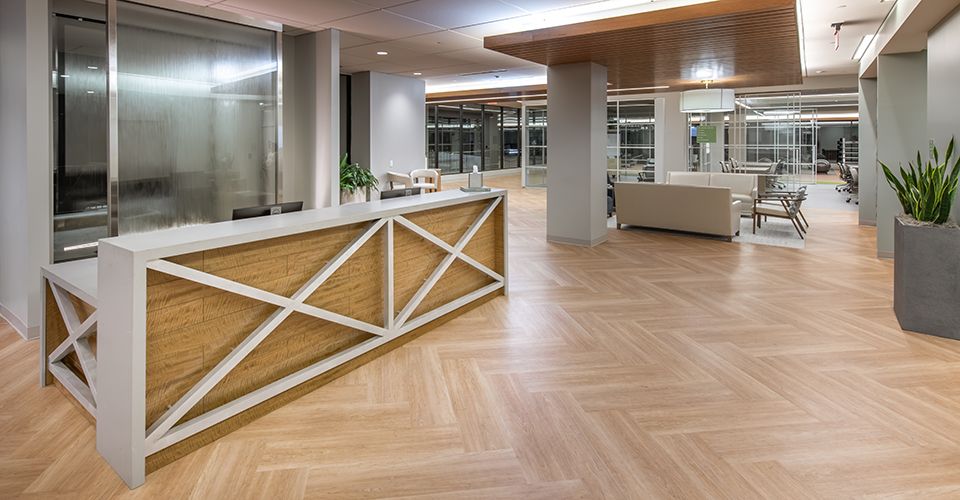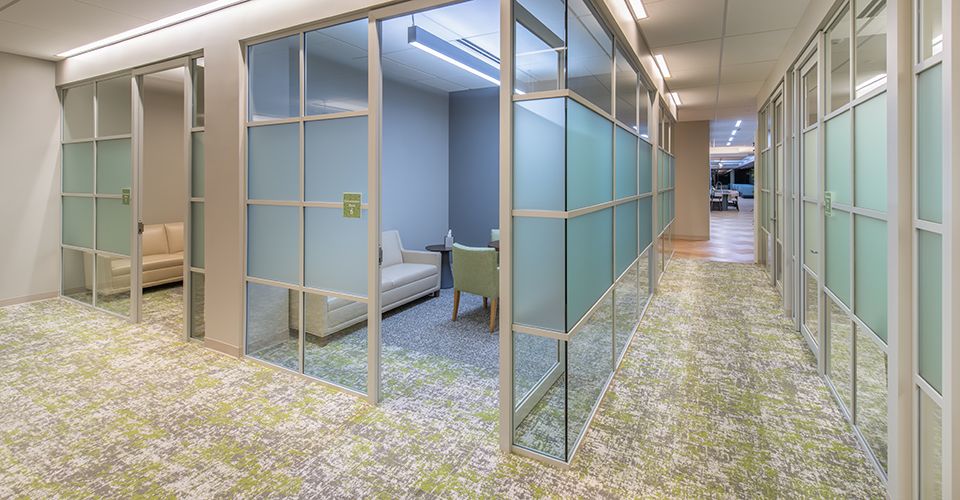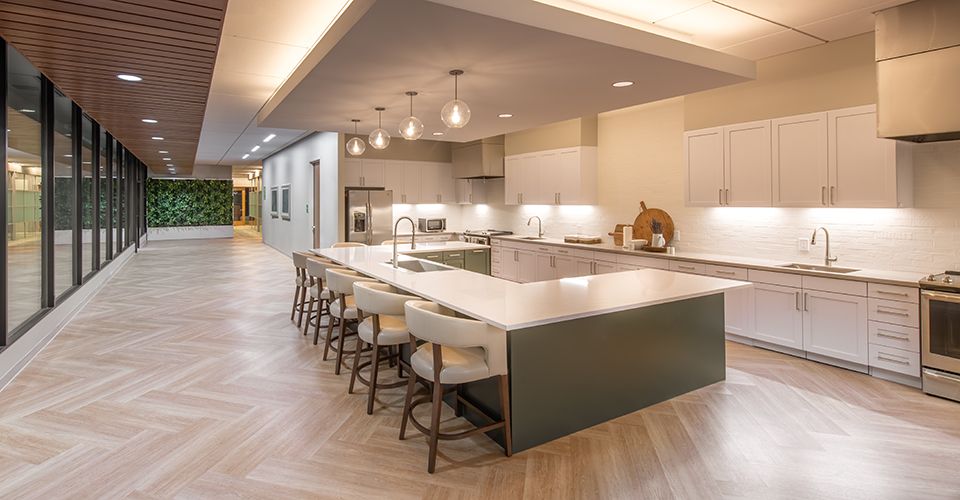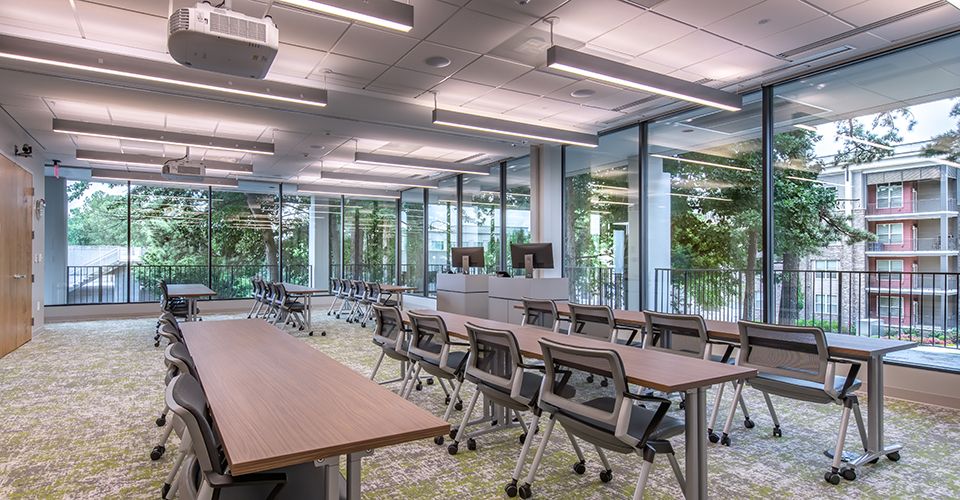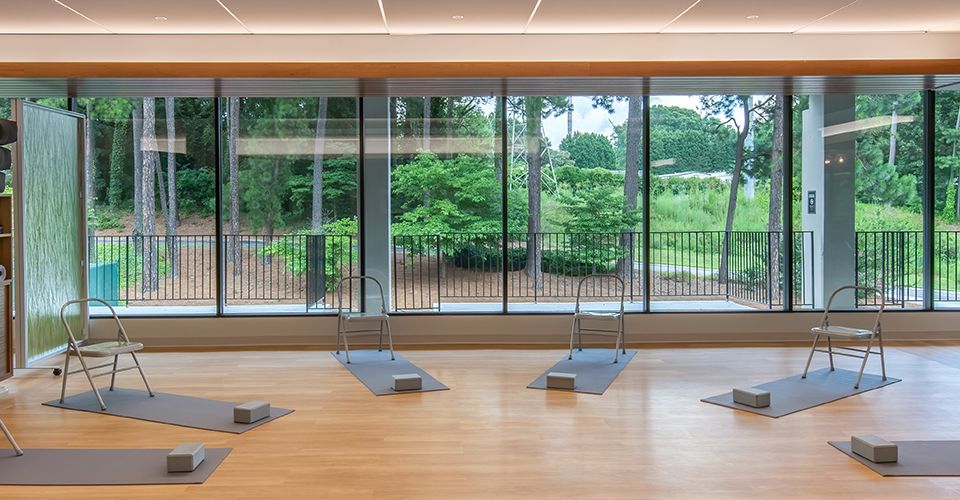Numerous publications on biophilic design show the benefits to those who live, work and heal in those spaces. The Mild Cognitive Impairment (MCI) Empowerment Program (MCIEP) aims to support individuals experiencing early declines in memory, a condition that impacts nearly one out of every five Americans over the age of 65. Generous support from the James M. Cox Foundation and Cox Enterprises allowed the Emory Brain Health Center and the Georgia Institute of Technology’s Institute for People and Technology to create a space for the MCIEP that fosters patient comfort and independence while also offering flexibility for various studies, patient activities and other uses. With these priorities in mind, the MCIEP design team selected Interface flooring for its biophilic design properties and Evidence Based Design (EBD) performance characteristics that support the program’s mission.
Focus on Buildings’ Effects on People
MCI, a condition where someone is undergoing relatively rapid declines in memory or reasoning that are not typical of their age, is a relatively new diagnosis. “This condition will be increasingly more important as it becomes more recognized,” said Craig Zimring, Director of SimTigrate Design Lab at Georgia Tech and head of the Built Environment core program for MCIEP. “Our members are typically people in their 70s or so, likely experiencing this decline as a result of the Alzheimer’s disease process, but they are not there yet.”
Founders were inspired to create the MCIEP when they identified a gap in care and service for this population. “When patients are diagnosed with MCI, there is no treatment. We want to change that, so we created a space for a full research program with Emory and Georgia Tech,” said Heather Fellows, Designer III, Nelson. “Researchers want to know why certain individuals’ memory improves, stays stagnant, or progresses into Alzheimer’s. This is a research facility to find answers to those questions.”
“At diagnosis, patients are given recommendations on modifications to their lifestyle in an effort to maintain or slow the decline in memory, but they aren’t offered any support on how or where to do that,” explained Dr. Amy Rodriguez, Director of Therapeutic Programs, Cognitive Impairment Program, Emory School of Medicine. “Our vision was to create a program and space that would give people the support they need to address these lifestyle factors.”
“EBD teaches us that people are impacted, positively or negatively, by their environments, so we wanted to take that into account when creating a space for this population,” said Zimring. “We did not want the MCIEP to feel like a clinical setting – not to remind people that they are declining, but rather to promote an uplifting, stimulating and supportive experience.”
Fostering Patient Comfort and Confidence
Key considerations for the MCIEP design included patient comfort and confidence. “These individuals are often already nervous and confused, so we wanted them to feel at home,” explained Fellows. “The notions of engagement and respect were key drivers in our decision making to avoid treating members as ‘less than,’” added Zimring. “These individuals’ worlds have shrunk, and their condition is difficult to discuss with friends and family. Therefore, providing a space for sharing and community was critical.”
The design team sought input from a patient family advisory team, comprised of MCIEP members’ family and caregivers who offered advice on the center’s overall look and feel. “We do stuff with people, not for people,” said Zimring. “The advisory members were involved in every step of the design and evaluation process,” added Rodriguez. “We wanted the space to feel like it was for them, not for us.”
Bringing the Outside In With Biophilic Design
One of the biggest takeaways from the patient family advisory team was a desire for a space influenced by and inclusive of nature. “They wanted to see nature incorporated in some way, as they felt it was really important to providing a calm, soothing environment for their loved ones,” said Rodriguez.
Designers incorporated biophilic design into their process to leverage the health and well-being benefits of nature.1 The MCIEP center is almost entirely surrounded by windows to allow abundant natural lighting and features a soothing color palette of greens. When it came to flooring, Fellows selected Interface LVT with natural woodgrain patterns, as well as a carpet tile featuring a moss-like design. “We wanted to incorporate touches of nature without making the space feel too busy or overwhelming – nature in a contained environment,” she explained. “For LVT, we went with a classic, natural wood look. The carpet has a beautiful moss feel, which both supports our biophilic design ambitions and also adds a pop of color for a bit of fun and personality.”
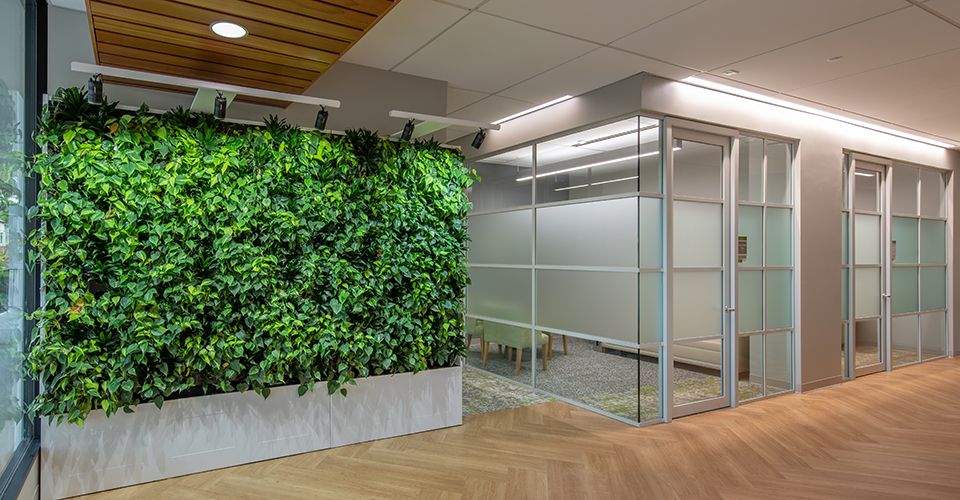
By consciously including nature in design, we are unconsciously reconnecting, bringing the great outdoors into our constructed world.
Interface Flooring Supports EBD Performance Characteristics
To satisfy the healthcare environment’s operational demands, it is critical to specify flooring that supports EBD performance. Interface flooring supports many of these performance characteristics. For example, Interface’s integrated flooring system allows designers to incorporate multiple flooring solutions with minimal surface transitions, helping to reduce slips, trips and falls. Interface flooring also supports improved patient and family satisfaction by offering “pattern with purpose” – providing visual appeal as well as supporting wayfinding to increase comfort and confidence while navigating the space.
One of the most important features of the MCIEP space is openness and wayfinding. “It is a unique, visually open space that draws you in,” explained Zimring. “That openness supports wayfinding as well, which is critical for a population challenged by navigation and social engagement. Wayfinding is one of the first abilities to decline with MCI, and it gets worse with anxiety. We wanted to eliminate that challenge for our members as much as possible.” Interface flooring solutions can be paired across collections and product type to create thoughtful designs that help guide users through the space.
Sufficient acoustics was also important for the MCIEP team, and they needed a flooring solution that would help dampen unwanted noise across the MCIEP center’s open floorplan. “We’re working with older patients with MCI, and speech discrimination is difficult for this population,” said Rodriguez. “The openness of the space is good for flexibility and visibility but can be a challenge acoustically.”
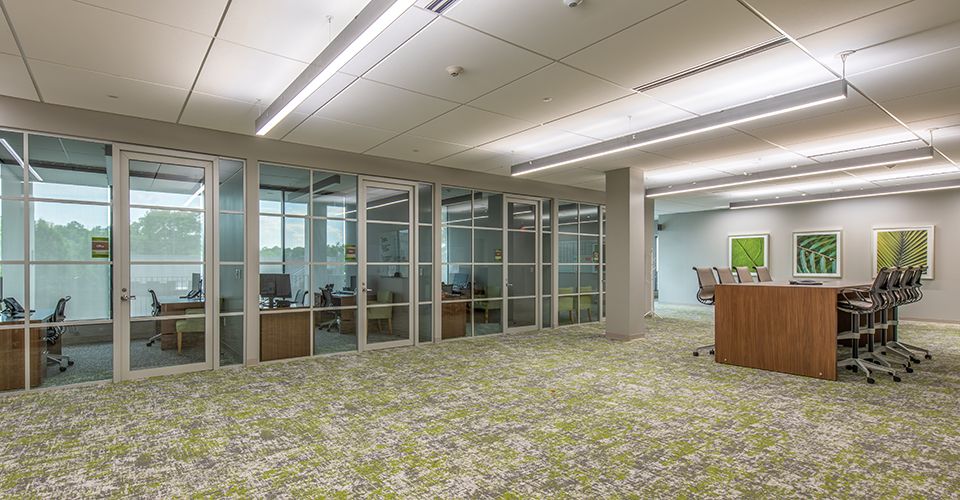
Soft surface flooring, like carpet tiles, offers exceptional sound absorption and is ideal for areas that require quiet for focus or privacy. (Product shown: Painted Gesture)
“Interface’s acoustical benefits were a significant part of my selection,” said Fellows. “The company’s carpet tiles offer sound absorption while its Sound Choice™ LVT is known to reduce impact sound, both of which were important for this project.”
To date, the MCIEP center has been well received by patients and their caregivers alike. “One member talked about how much they love the space and that they are so thankful to have it,” said Fellows. “It’s wonderful to hear that feedback as we don’t always get to hear from the end user like that. This is for them.”
This positive feedback bolsters Fellows’ confidence in choosing Interface again for future projects. “I intentionally specify Interface, especially for my healthcare projects,” said Fellows. “The product looks and performs so good, and our Interface team offers next level customer service to ensure our clients are happy.”
